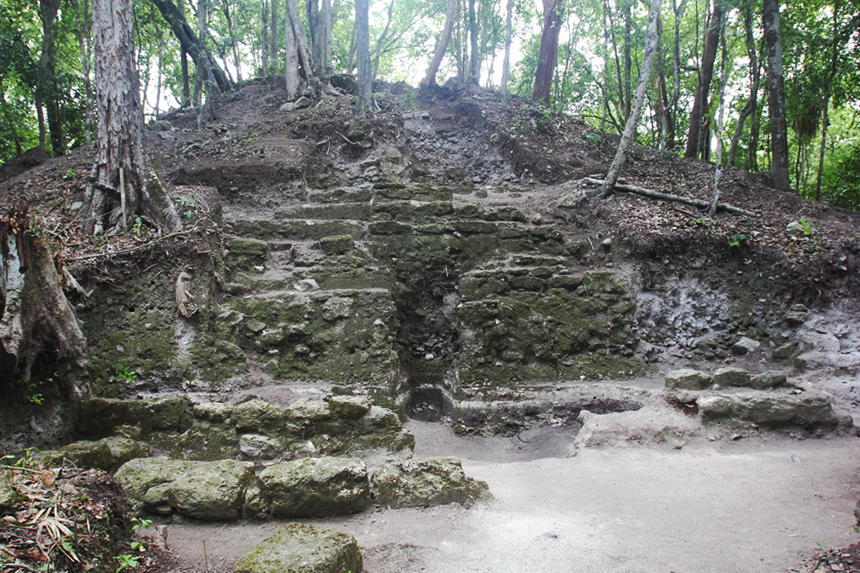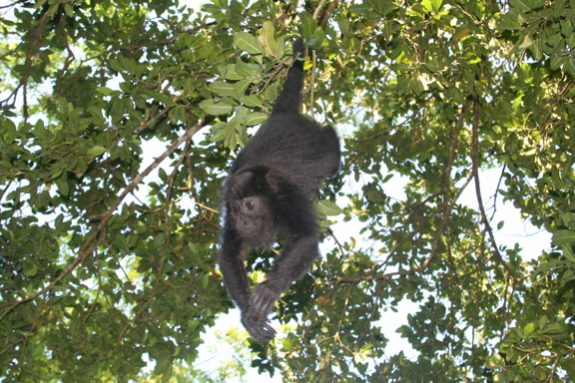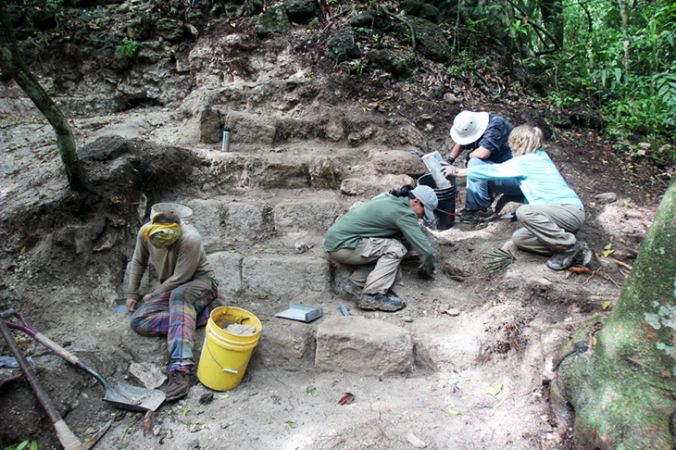Digging into the Maya mystery
In a Central American jungle, archaeologists and volunteers uncover ruins of the once-powerful civilization

Abandoned more than 1,000 years ago and covered by jungle growth, this stone pyramid at the ancient Maya site of Nojol Nah in Belize was revealed through careful excavation by archaeologists and volunteers.
Charles Q. Choi
In the jungles of Belize, near the southern border of Mexico, rise giant stone pyramids. I’ve seen deadly snakes lurk in this area, as well as venomous scorpions, tarantulas the size of a grownup’s hand and swarms of killer bees. Despite these dangers, volunteers such as myself come here to help archaeologists at the site uncover clues to a longstanding mystery. The question that we hope to answer: What caused the collapse of the ancient empire that created these monuments?
The ancient Maya civilization was an empire the size of Texas. Its cities and fields occupied what is now southern Mexico and northern Central America, including the countries of Guatemala, Belize, El Salvador and Honduras. The height of the Maya empire, known as the Classic period, stretched from approximately A.D. 250 to at least 900. During this time, at least 5 million and perhaps as many as 25 million people lived there. The empire’s population density, or people per square mile, was greater than that of medieval Europe.
The Maya had what was arguably the most advanced civilization in the Americas. For example, they made dramatic breakthroughs in astronomy that helped them very accurately predict where the moon and other planets would be in the sky centuries in the future. They also left behind many books and stone inscriptions that recorded the stories of their gods and the history of their divine kings and queens. These historical records were written in a language made of hieroglyphs, special pictures that represent words or sounds.
Then, for unknown reasons, the ancient Maya civilization collapsed more than a thousand years ago. The number of people declined catastrophically to a fraction of the empire’s former size. The ruins of its great cities are now largely overgrown by jungle. The descendents of this civilization, the modern Maya, still live in the Americas.
Scientists want to solve the puzzle about how the ancient Maya lived and what ended their civilization. To do so, the Maya Research Program has been investigating for two decades an area known as Blue Creek, in western Belize. This region is named after the nearby Rio Azul, which means “blue river” in Spanish.
Life in Blue Creek
Some 25,000 Maya once called Blue Creek home. This would have made it a relatively small population center. However, the area appears to have been unusually important. For instance, the fifth-largest known ancient Maya cache of jade — a precious stone — was discovered at Blue Creek. In ancient Maya culture, jade buried with a person often means the person was important (or perhaps connected to someone important). At Blue Creek, “even graves of poor folk there have been found with jade,” said Tom Guderjan, director of the Maya Research Program.
Every summer, researchers and volunteers such as myself make camp at Blue Creek. Our dwellings are hilltop cabins made of metal sheets. In this manner, we are like the ancient Maya, who preferred living up high, where the air is breezier and clear of many of the mosquitoes buzzing down near the water.
Around the camp are sugarcane fields and cattle pastures that are often misty at daybreak. These mostly belong to nearby communities of Mennonites. Many people in this religious group still avoid using present-day technology and can be seen riding the roads in horse-drawn buggies. Others, however, do use tractors and other modern conveniences.
Digging in the ruins
Research at Blue Creek involves us crowding into pickup trucks every morning. We drive over very bumpy and often muddy roads, sometimes in the pouring rain. The way we swerve back and forth and bounce up and down can make it feel like we’re riding in a roller coaster and on a bucking bronco at the same time.
On some days, we hunt for new Maya sites in Blue Creek. This involves roaming the jungle, chopping our way past vines with machetes. Many ancient Maya buildings are visible as bumps on top of nearby hills.

We do keep an eye out for venomous snakes and other dangerous animals. However, most wildlife we see is relatively harmless, like the howler monkeys that wail loudly in the morning. Still, they do like to throw poop at people, and my group keeps an eye on the treetops ever since one of my friends was hit with monkey droppings.
Research crews work on a variety of structures, including buildings where Maya lived and pyramids where sacred rituals took place. Excavating them involves first using shovels and pickaxes to remove most of the soil that covers the buildings. Crews then chop down trees and cut roots at the site. All of this can take hours — if not days — of dirty, sweaty work. To keep us going, Maya Research Program intern Sam Mclellan blasts music from his iPod through speakers. It can feel epic hanging from a vine on the side of a pyramid while digging away in the rain to the sounds of heavy metal.
Carefully uncovering ancient secrets
We begin digging with more care when the earth turns from dark brown to pale tan. This change in color suggests we are getting closer to the white limestone from which ancient Maya ruins were made. We switch to paintbrushes, handpicks and trowels so that we don’t risk damaging any artifacts we might discover.
Everything we are looking for is mostly hidden, so finding it can be very challenging. How do we dig to expose buildings and not accidentally destroy something valuable?
Greg Savoie of the Maya Research Program says that when things get confusing, it helps to know a bit about how the ancient Maya thought. For instance, Savoie said, “they liked their buildings symmetrical.” He pointed out to his crew at Chum Balam-Nal the likely layout of a structure being unearthed. “If we find a rounded corner on one side of the building,” he explained, “we should expect to find another one on the other side.”

Human remains such as bones and teeth can reveal what diseases the ancient Maya faced, or whether they were sacrificed. Even broken sherds of pottery can provide vital details. For instance, a type of pot decoration known as a basal flange can reveal that it came from the Early Classic period, A.D. 250 to 600, explained Maya Research Program’s Colleen Hanratty. On the other hand, a kind of dark coloring known as Achote Black may designate a piece that came from the Late Classic period, A.D. 600 to 830, she said.
Hours or days of hard work can pass before someone finds an artifact or uncovers a building. Still, the feeling you get when you discover something is an extraordinary reward. In June, our group discovered human statuettes, for instance, on top of a three-story-tall pyramid. They might have been left there as offerings after the fall of the ancient Maya, perhaps by their descendents.
In a 2008 expedition, I helped discover a chamber underneath a building that apparently once held a shrine. Underground spaces were often sacred to the ancient Maya, who believed such places were connected with the underworld.
A big picture built of many pieces
Over the past few decades, the Maya Research Program has gathered many clues about what life in Blue Creek was once like. Any one artifact usually has very little meaning by itself and instead gains significance when archaeologists see how it connects with other finds or its surroundings. For instance, if an item was found in a grave, it was probably valued. If it was found in a garbage heap outside a house, it probably had little value.
To archaeologists, even that “garbage” offers clues to understanding why the ancient Maya disappeared.
Volunteers and researchers with the Maya Research Program are not in the jungles of Belize to hunt treasure but to save it. Though looters who steal valuable artifacts can do incalculable harm to archaeologists’ understanding of the ancient empire, criminals have unfortunately raided a number of sites at Blue Creek. Luckily, scientists running this excavation are friendly enough with the local community to at times retrieve stolen artifacts.
The picture that researchers are developing of ancient Blue Creek suggests it was a significant site. It was located at the end of a major river used as an important trade route by the ancient Maya. The site also contains a vast network of ditches that helped irrigate fields with water. That would have made crop production very efficient, said Maya Research Program’s Samantha Krause.
Indeed, such details might explain why Blue Creek acquired unusual wealth. They might also help explain the end of the ancient Maya civilization.
The empire was made of many kingdoms and communities that grew increasingly dependent on each other over time. That dependence might also have made each community less capable of surviving on its own. Blue Creek apparently grew more crops than it needed, which would have allowed it to ship extra food to help feed other areas. The prevailing idea on why the ancient Maya culture disappeared is that environmental catastrophes such as droughts disrupted the networks that tied communities together. A catastrophe that endangered Blue Creek, for instance, might have had domino effects, rapidly causing disasters to develop in neighboring communities.
“The ancient Maya had a much more complex society than they’re often given credit for, and they might have lessons for our own time,” Guderjan said. “We live in a world where we face challenges with our environment, and our society is connected tightly with others.”
Blue Creek might also point to the complexity of the collapse of the ancient Maya civilization. For instance, while the main plaza at the center of Blue Creek was abandoned roughly between A.D. 830 and 1100, Chum Balam-Nal and other sites may have survived longer, by another generation or so, Savoie said. That might mean these areas allied themselves with outsiders as the ancient Maya culture was collapsing.
Clearly, Guderjan says, “There’s much more that Blue Creek has to teach us.”







